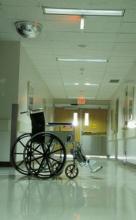Disclosure and apology programs may be one answer to reducing malpractice litigation against physicians, hospitals, and other health care providers.
Pilot efforts in this area by the University of Illinois Hospital and Health Sciences System, Chicago, since 2006 have increased adverse event reports from 1,500 per year to 10,000 while decreasing malpractice premiums by $15 million dollars since 2010.
"Through effectively communicating, you can eliminate a whole lot of lawsuits [in which] the patients and families are suing you just because they want answers," said Dr. Tim McDonald, chief safety and risk officer for health affairs for the system. "We think that’s one of the big keys to substantially reducing malpractice costs."
So-called communication and resolution programs (CRPs) involve investigating events in which inappropriate care may have occurred, providing an apology to patients, and offering early compensation if deemed necessary.
Under such programs, physicians or administrators immediately communicate with patients after a poor medical outcome or questionable circumstance and explain that the event is being rapidly investigated.
Once investigation is complete, risk managers or administrators discuss the findings with the patient and the clinician. The team admits any errors and provides an apology to the patient or family if harm was caused. If care was deemed substandard, administrators offer the patient or family appropriate compensation. In the event the care was deemed reasonable, the involved physician and risk manager explain their conclusions and seek understanding, but commit to defending the clinician in court, if necessary.
The CRP program at Illinois was modeled after a similar program at the University of Michigan Health System, Ann Arbor, which started in late 2001. Since the program began, the average legal expenses per case has been cut at least in half, according to the UM website. In July 2001, the health system had 260 pre-suit claims and lawsuits pending; it now averages about 100/year.
Contributing factors to the success of six early adopters – including the Michigan and Illinois programs – included sufficient resources to fund the ventures, a passionate program advocate, and strong marketing, according to an analysis in the journal Health Affairs.
"The things that really distinguished [the successful early adopters] from the later adopters were they had an incredibly strong champion of the program who made it his job to build the program full time," said Michelle Mello, J.D., Ph.D., director of the law and public health program at Harvard School of Public Health, Boston (Health Aff. 2014;33:120-9).
Ascension Health, a large system of more than 1,900 hospitals in 23 states and the District of Columbia, saw a 52% decrease in the total number of actual and potential liability cases in a demonstration project of an obstetrical CRP (Health Aff. 2014;33:139-45).
The program included the immediate reporting of unexpected events, investigation, documentation and causal analysis, as well as having staff fully disclose unexpected events to patients and families. To do so, each of five hospitals in the pilot created an Obstetrics Event Response Team that consisted of an obstetrician, a neonatologist, an obstetrics nurse manager, a risk manager, and a medical coder.
Following training, the teams became accountable for immediate identification and reporting of any event that resulted in patient harm, expedited investigation of the event, prompt and ongoing disclosure, early resolution of events involving probable liability, and accessing lessons learned from each event to improve patient care.
In just over 3 years after implementation of the demonstration project, the rate of full disclosures more than doubled (221% increase in full disclosures).
"Based on the success of the ... demonstration project, Ascension Health has begun to spread the care model – including electronic fetal monitoring (EFM) and shoulder dystocia e-learning stimulation, TeamSTEPPS training, disclosure and root cause analysis training, and implementation of the Ascension Health shoulder dystocia bundle – as a standard for all obstetrics units throughout the health system," said Ann Hendrich, RN, Ph.D., senior vice president for quality and safety at Ascension Health.
Adoption of CRPs is not without challenges. Participants at five of the six early adoption sites reported practical challenges in educating physicians about the program. Program founders initially struggled to soothe physicians’ skepticism and discomfort with making disclosures to patients. Strong communication by administrators and trust building with physicians was key in overcoming these obstacles, Dr. Mello and her colleagues found.
CRPs would be easier to implement if the current legal and governmental environment supported them, health care experts said (Health Aff. 2014 33:111-19). State laws that prohibit using health care providers’ apologies against them in court would go far to support CRPs. Currently, more than 30 states have some form of apology statute aimed at physicians and other health care providers, but the extent of legal protection differs.

